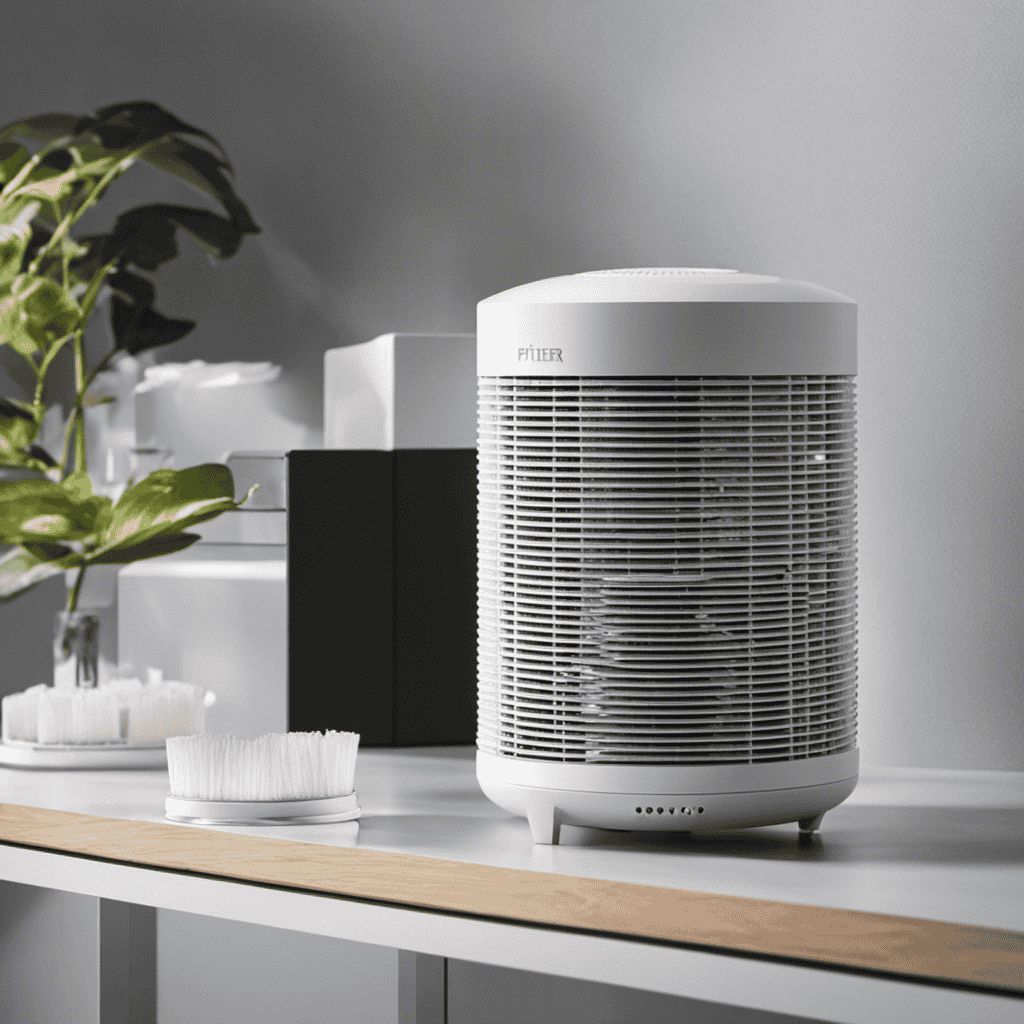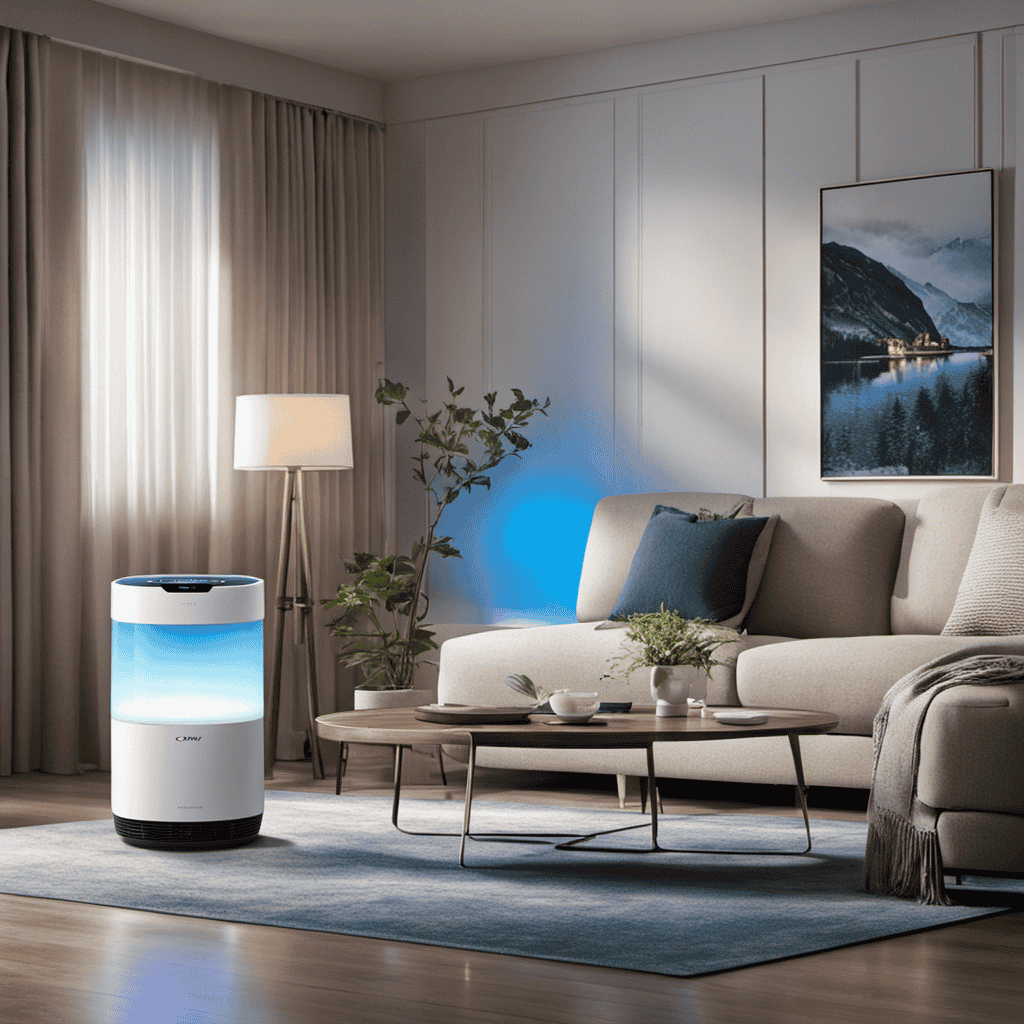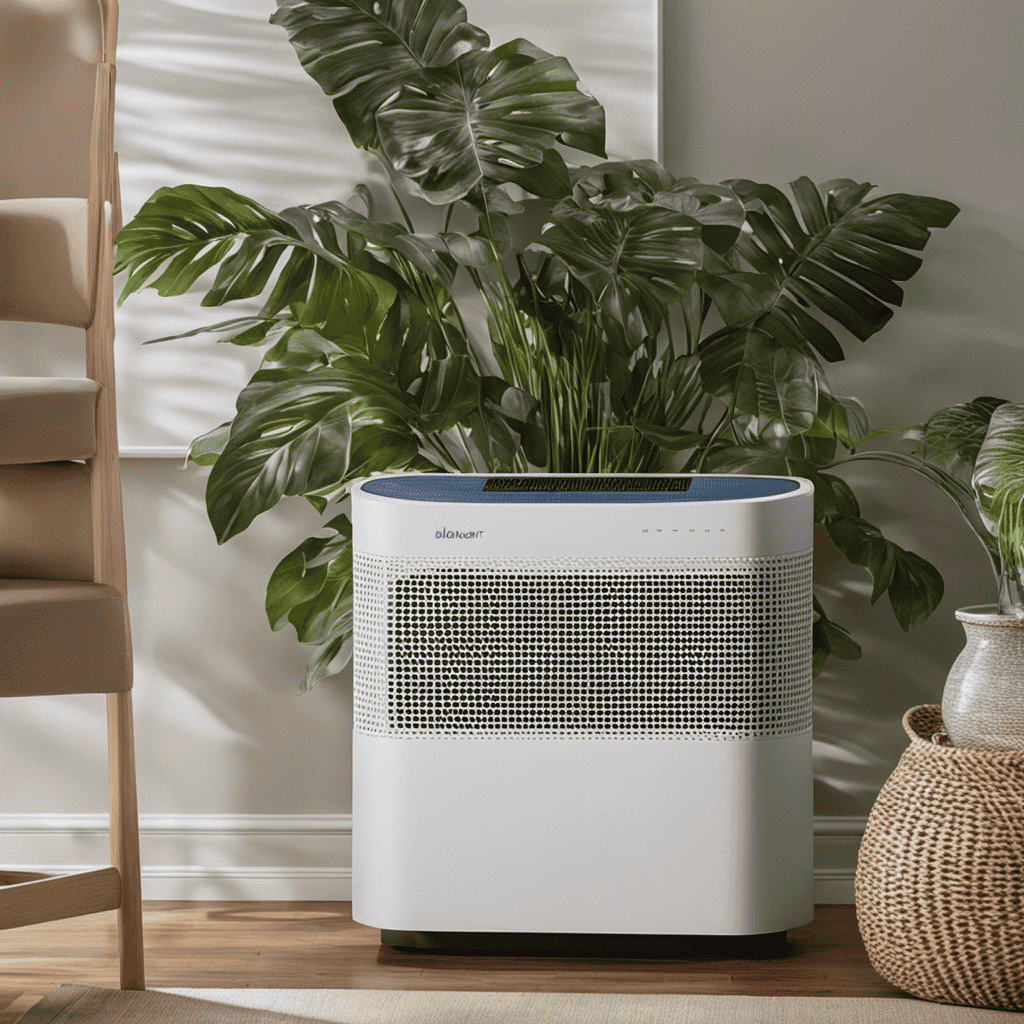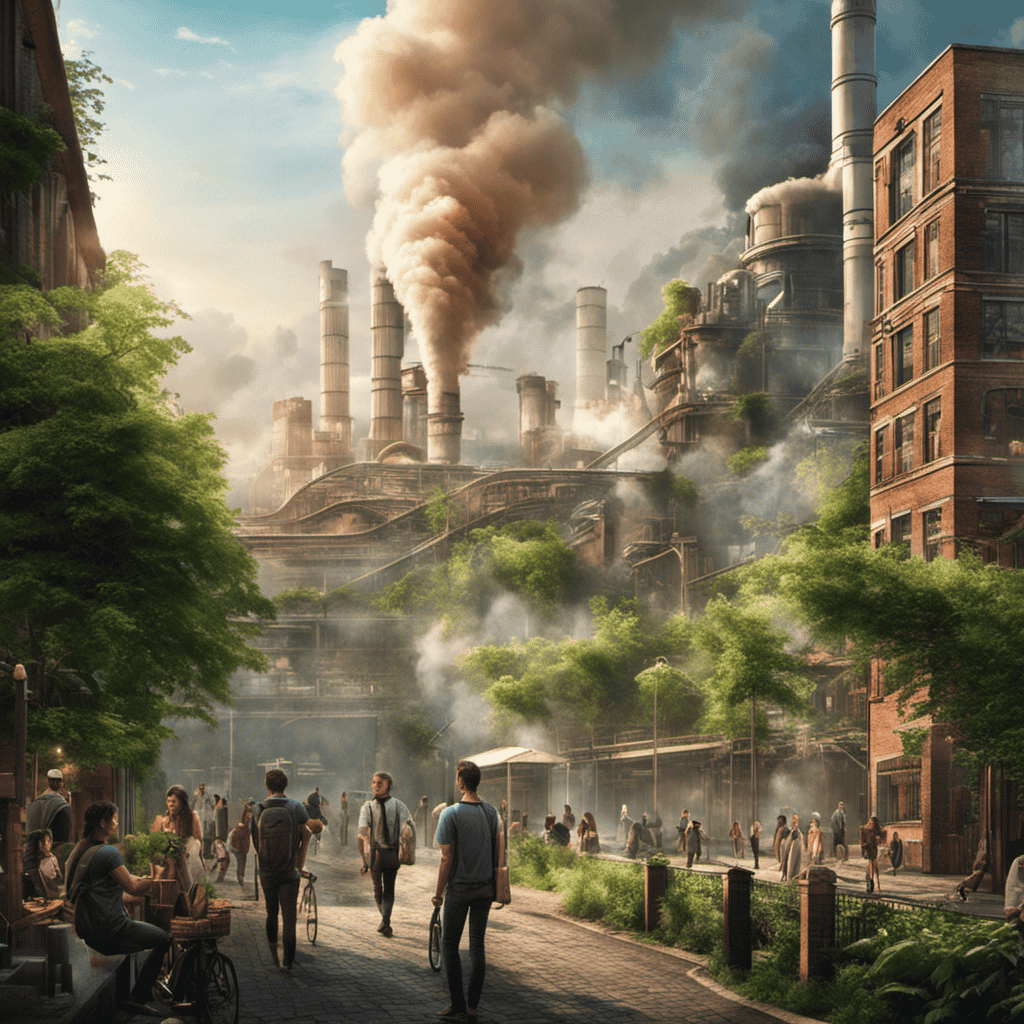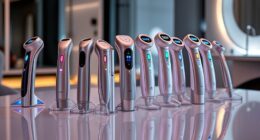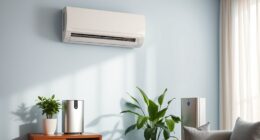As someone who owns an air purifier, I recognize the significance of keeping indoor air clean and fresh.
One crucial aspect of this maintenance is regularly cleaning the filter.
In this article, I will guide you through the step-by-step process of cleaning your air purifier filter.
By following these instructions and avoiding common mistakes, you can ensure that your air purifier functions at its best, providing you with clean and healthy air for years to come.
Let’s dive in and learn how to clean the filter of your air purifier effectively.
Key Takeaways
- Regular filter cleaning is important for maintaining air purifier efficiency and effectiveness.
- Clean filters trap more airborne particles, ensuring cleaner and healthier air.
- Clogged filters restrict airflow, reducing the air purifier’s cleaning ability.
- Different types of filters have different benefits, so choose the right filter based on your specific needs and air quality concerns.
Importance of Regular Filter Cleaning
Regularly cleaning your air purifier’s filter is important in maintaining its efficiency and effectiveness. The importance of filter maintenance cannot be overstated when it comes to the performance of your air purifier.
A clean filter allows the purifier to trap more airborne particles, such as dust, pollen, and pet dander, ensuring that the air in your home is cleaner and healthier. When the filter becomes clogged with these particles, the purifier’s airflow is restricted, reducing its ability to effectively clean the air.
Understanding the Different Types of Air Purifier Filters
To understand the different types of filters for your air purifier, you’ll want to research and compare the options available. Each type of filter has its own benefits and advantages, so it’s important to choose the right one for your specific needs.
Here are three common types of air purifier filters and the benefits of each:
-
HEPA Filters: High-Efficiency Particulate Air (HEPA) filters are known for their ability to capture 99.97% of airborne particles as small as 0.3 microns. They are effective in removing allergens, dust, pet dander, and mold spores from the air. HEPA filters are ideal for individuals with allergies or asthma.
-
Carbon Filters: Carbon filters are designed to remove odors, gases, and volatile organic compounds (VOCs) from the air. They contain activated carbon, which has a large surface area that can absorb and trap odorous molecules. Carbon filters are beneficial for households with smokers, pets, or strong cooking smells.
-
UV-C Filters: UV-C filters use ultraviolet light to kill bacteria, viruses, and other microorganisms in the air. They are effective in reducing the spread of germs and preventing the growth of mold and mildew. UV-C filters are particularly useful in areas with high humidity or where there is a concern for airborne illnesses.
When choosing an air purifier filter, consider your specific needs and the air quality concerns in your environment. Understanding the different types and their benefits will help you make an informed decision.
Tools and Materials Needed for Cleaning the Filter
When it comes to maintaining your air purifier, it’s important to have the necessary tools and materials on hand for cleaning the filter. Proper maintenance ensures that your air purifier continues to function effectively and efficiently.
There are alternative cleaning methods and DIY filter cleaning techniques that can help extend the lifespan of your filter. One of the tools you’ll need is a vacuum cleaner with a brush attachment to remove dust and debris from the filter. Additionally, having a soft brush or cloth will allow you to gently wipe away any remaining dirt.
Some DIY cleaning techniques involve soaking the filter in a mixture of warm water and mild detergent, followed by thorough rinsing and drying. Remember to refer to your air purifier’s user manual for specific cleaning instructions and to ensure you have the right tools and materials for the job.
Step-by-Step Guide to Cleaning the Filter
When it comes to maintaining the efficiency of your air purifier, effective cleaning techniques and the frequency of filter cleaning are crucial factors to consider.
Proper cleaning techniques ensure that the filter is free from dust, allergens, and other particles, allowing it to effectively purify the air in your space.
Understanding the recommended frequency of filter cleaning helps to prevent clogging and ensure optimal performance of your air purifier.
Effective Cleaning Techniques
Make sure you’re using a soft brush to gently remove any dust or dirt from the air purifier filter. This is one of the most effective cleaning techniques for maintaining optimal performance and prolonging the life of your filter.
Here are some best practices to follow when cleaning your air purifier filter:
-
Vacuum: Use a vacuum cleaner with a brush attachment to remove large particles and debris from the filter. This will help to prevent clogging and improve the overall efficiency of the filter.
-
Rinse: If your filter is washable, rinse it under running water to remove any remaining dirt or dust. Be sure to follow the manufacturer’s instructions for proper cleaning and drying.
-
Dry: Allow the filter to dry completely before reinserting it into the air purifier. This will prevent mold and bacteria growth and ensure that the filter functions effectively.
Frequency of Filter Cleaning
Using a soft brush and rinsing the washable filter under running water will help maintain optimal performance and prolong the life of your air purifier.
It is important to regularly clean your air purifier’s filter to ensure its efficiency. The frequency of filter cleaning depends on several factors, including the environment in which the air purifier is used and the manufacturer’s recommendations. In general, it is recommended to clean the filter every 1-3 months.
Regular maintenance and cleaning of the filter have several benefits. It helps to remove accumulated dirt, dust, and other particles from the filter, allowing it to effectively capture airborne pollutants. Additionally, regular filter cleaning ensures proper airflow, preventing strain on the motor and extending the lifespan of your air purifier.
How Often Should You Clean Your Air Purifier Filter
Cleaning the air purifier filter regularly is crucial to maintain its optimal performance. According to industry recommendations, the frequency of cleaning depends on various factors such as the environment, usage, and the type of filter. Signs of a dirty filter include reduced airflow, a noticeable decrease in air quality, and an increase in dust accumulation in the room.
Neglecting to clean the filter can result in decreased efficiency, reduced lifespan of the air purifier, and potentially harmful particles being released back into the air.
Cleaning Frequency Recommendations
It’s important to regularly check the manufacturer’s recommendations for cleaning frequency of the air purifier filter. Different air purifiers have different cleaning requirements, so it’s crucial to follow the guidelines provided by the manufacturer to ensure optimal performance.
Here are some general frequency recommendations for cleaning your air purifier filter:
-
Monthly cleaning: Some air purifiers require monthly cleaning to maintain their effectiveness. This is especially true if you live in a dusty or polluted area.
-
Quarterly cleaning: For air purifiers in less polluted environments, cleaning the filter every three months is usually sufficient. Regular maintenance helps prevent the build-up of dust and allergens.
-
Annual deep cleaning: In addition to regular cleaning, it’s recommended to perform a thorough deep cleaning of the air purifier filter at least once a year. This involves removing the filter and washing it with mild soap and water.
Signs of a Dirty Filter
Regularly checking the manufacturer’s recommendations is essential to ensure optimal performance of the air purifier.
Filter maintenance is a crucial aspect of keeping your air purifier functioning properly. Over time, the filter collects dust, allergens, and other airborne particles, which can hinder its efficiency. Signs of a dirty filter include reduced airflow, decreased air quality, and a noticeable decrease in the air purifier’s effectiveness.
To address this issue, filter replacement is necessary. Most manufacturers suggest replacing the filter every 6 to 12 months, depending on usage and the level of pollutants in your environment.
Neglecting filter maintenance can have a significant impact on the air purifier’s overall performance and its ability to effectively clean the air in your home or office.
Impact of Neglecting Cleaning
Neglecting to maintain the filter can significantly affect the performance of your air purifier. The filter plays a crucial role in removing impurities from the air and ensuring clean and healthy indoor air quality. Here are three key effects of a dirty filter on air quality and the potential health risks of not cleaning your air purifier filter:
-
Reduced filtration efficiency: A clogged filter restricts airflow and hampers the air purifier’s ability to capture pollutants effectively. This leads to a decline in overall air quality as the filter becomes less efficient in trapping dust, pollen, pet dander, and other allergens.
-
Increased allergens and irritants: When the filter is dirty, it cannot effectively remove allergens and irritants from the air. This can worsen allergies, asthma symptoms, and respiratory conditions. Poor air quality can also lead to headaches, fatigue, and other health issues.
-
Decreased lifespan of the air purifier: A neglected filter puts added strain on the air purifier’s motor and fan, leading to premature wear and tear. This can result in costly repairs or the need for a replacement unit.
Regularly cleaning or replacing the filter in your air purifier is essential for maintaining optimal air quality and preventing potential health risks.
Signs That Your Air Purifier Filter Needs Cleaning
If you notice a decrease in air flow or a musty smell, your air purifier filter may need cleaning. Regular maintenance of your air purifier filter is important to ensure its optimal performance and to enjoy the benefits of clean air. Cleaning the filter not only improves air flow but also helps eliminate allergens, dust, and odors, creating a healthier indoor environment. Here are some signs that indicate your air purifier filter needs cleaning:
| Signs | Description |
|---|---|
| Decreased Air Flow | Reduced air circulation may indicate a clogged filter. |
| Musty Odor | A musty smell indicates the presence of mold or mildew in the filter. |
| Visible Dirt or Dust | If you can see dirt or dust accumulation on the filter, it’s time to clean it. |
| Allergy Symptoms | Increased allergy symptoms suggest a dirty filter that is not effectively removing allergens. |
| Higher Energy Consumption | A dirty filter causes the air purifier to work harder, leading to increased energy consumption. |
Regularly cleaning your air purifier filter will not only improve its performance but also ensure the long-term efficiency and effectiveness of your air purifier. It is recommended to clean the filter every 1-3 months, depending on the manufacturer’s instructions, to maintain optimal air quality in your living space.
Common Mistakes to Avoid When Cleaning the Filter
When cleaning the filter, be sure to avoid these common mistakes. Here are some tips for cleaning your air purifier filter correctly:
-
Neglecting to read the manufacturer’s instructions: Each air purifier model may have specific cleaning instructions and guidelines. It’s crucial to carefully read and follow these instructions to avoid damaging the filter or the device itself.
-
Using the wrong cleaning method: Different types of filters require different cleaning techniques. For example, some filters can be washed with water, while others need to be replaced. Using the wrong cleaning method can reduce the filter’s efficiency or even render it unusable.
-
Failing to clean or replace the filter regularly: Regular maintenance is essential for optimal performance. Neglecting to clean or replace the filter as recommended by the manufacturer can result in reduced air quality and decreased efficiency of your air purifier.
Tips for Extending the Lifespan of Your Air Purifier Filter
Regular maintenance techniques are essential for ensuring the optimal performance and longevity of your air purifier filter. It is important to follow a regular filter replacement schedule to maintain the efficiency of your air purifier.
In addition to replacing the filter, effective cleaning methods can also be employed to remove any dirt or debris that may accumulate on the surface.
Regular Maintenance Techniques
To keep your air purifier running efficiently, it’s important to regularly clean the filter. Regular maintenance plays a crucial role in ensuring that your air purifier continues to provide clean and fresh air for your home or office. Here are three key reasons why regular filter cleaning is essential:
-
Improved Air Quality: Clean filters remove dust, pollen, pet dander, and other airborne particles, resulting in better indoor air quality and reducing respiratory issues.
-
Enhanced Performance: A clean filter allows the air purifier to work more efficiently, maximizing its performance and reducing energy consumption.
-
Prolonged Lifespan: Regularly cleaning the filter helps prevent clogging and extends the lifespan of your air purifier, saving you money in the long run.
Filter Replacement Schedule
It’s important to keep track of the recommended schedule for replacing your air purifier’s filter. The filter replacement frequency varies depending on the type of filter and the manufacturer’s guidelines. However, as a general rule of thumb, it is recommended to replace the filter every 6 to 12 months.
Clean filters not only ensure the proper functioning of your air purifier but also provide several benefits. They effectively remove allergens, dust, and other airborne particles, improving the air quality in your home. Clean filters also help to extend the lifespan of your air purifier by preventing the buildup of debris that can clog the system.
Now that we understand the importance of regular filter replacement, let’s dive into effective cleaning methods to keep your air purifier running smoothly.
Effective Cleaning Methods
Now that you understand the importance of keeping your air purifier running smoothly, let’s explore some effective cleaning methods. Regular cleaning of your air purifier is essential to maintain its efficiency and prolong its lifespan. Here are some best practices for cleaning your air purifier:
-
Dust the exterior: Use a soft cloth or a vacuum cleaner with a brush attachment to remove dust from the exterior surfaces of the air purifier. This will prevent dust buildup on the fan and vents.
-
Clean the filter: Depending on the type of air purifier, the filter may need to be cleaned or replaced. Follow the manufacturer’s instructions to remove and clean the filter properly. Rinse it under running water or use a vacuum cleaner to remove dust and debris.
-
Wipe down the interior: Use a damp cloth to wipe down the interior surfaces of the air purifier, including the fan blades and vents. This will remove any accumulated dirt or grime, ensuring optimal airflow.
Alternative Methods for Cleaning Air Purifier Filters
There are other ways you can clean air purifier filters. If you’re looking for alternative cleaning methods that are eco-friendly, there are a few options you can consider.
One method is to use vinegar and water solution to clean the filter. Mix equal parts of vinegar and water, soak the filter in the solution, and rinse it thoroughly before drying.
Another option is to use baking soda, which is known for its natural cleaning properties. Make a paste by mixing baking soda with water, apply it to the filter, scrub gently, and rinse off.
These alternative cleaning methods are not only effective in removing dirt and debris but also environmentally friendly, as they don’t require the use of harsh chemicals.
Maintaining Clean Air in Your Home: Beyond Just Cleaning the Filter
To maintain a clean and healthy home environment, you should regularly vacuum carpets and upholstery to remove dust and allergens. However, maintaining clean air in your home goes beyond just cleaning the filter of your air purifier.
Here are three alternative cleaning methods that can help improve the air quality in your home:
-
Natural air purifiers: Plants like peace lilies and spider plants can help remove toxins from the air, making it cleaner and fresher.
-
Proper ventilation: Opening windows and using exhaust fans can help remove stale air and bring in fresh air from outside, reducing indoor air pollution.
-
Regular deep cleaning: Besides vacuuming, deep cleaning surfaces and objects can eliminate dust mites, pet dander, and other allergens that contribute to poor air quality.
The benefits of clean air cannot be overstated. It can improve respiratory health, reduce allergy symptoms, and create a more pleasant and comfortable living environment. By incorporating these alternative cleaning methods, you can ensure that the air in your home remains clean and healthy.
Frequently Asked Questions
Can I Clean My Air Purifier Filter With Just Water, or Do I Need to Use a Cleaning Solution?
I prefer using a cleaning solution to clean my air purifier filter as it helps to remove stubborn dirt and bacteria effectively. However, if you don’t have a cleaning solution, you can also clean the filter with just water.
Is It Okay to Vacuum My Air Purifier Filter Instead of Washing It?
Yes, it is possible to vacuum your air purifier filter as an alternative cleaning method. However, it is important to note that vacuuming may not remove all the dirt and dust particles, so washing the filter is still recommended for thorough cleaning.
Can I Clean My Air Purifier Filter in the Dishwasher?
No, it is not safe to clean your air purifier filter in the dishwasher. Dishwashers can damage the filter and affect its performance. There are alternative cleaning methods that are recommended for maintaining the filter’s effectiveness.
How Long Does It Take for the Air Purifier Filter to Dry After Cleaning?
After cleaning an air purifier filter, it typically takes a few hours to dry completely. This is an important step in air purifier filter maintenance to ensure optimal performance. Proper drying prevents mold and bacteria growth.
Should I Wear Gloves or a Mask When Cleaning My Air Purifier Filter?
When cleaning my air purifier filter, I always wear gloves and a mask to protect myself from any dust or allergens that may be trapped in the filter. Safety is important!
Conclusion
In conclusion, my dear readers, I must say that the process of cleaning your air purifier filter is no small feat. It requires dedication, patience, and a whole lot of cleaning supplies.
But fear not, for the rewards of a clean filter are worth it. Not only will you be breathing in fresh, purified air, but you’ll also be saving the world, one particle at a time.
So, my fellow air purifier enthusiasts, let us continue on this noble quest to maintain clean air in our humble abodes. Together, we can conquer the dust and conquer the world!
